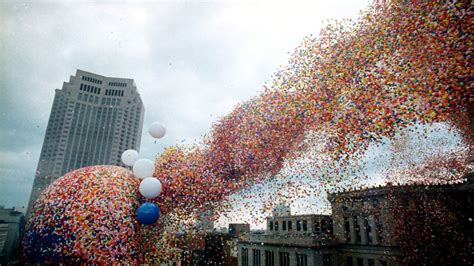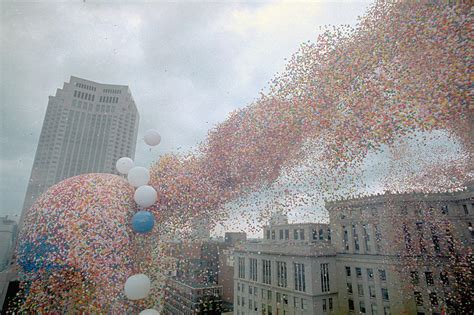
A 1986 publicity stunt gone awry in Cleveland, Ohio, dubbed “Balloonfest ’86,” serves as a stark reminder of the potential environmental and logistical consequences of large-scale events, even decades later. The release of nearly 1.5 million balloons, intended to be a world record and a visually stunning spectacle, quickly turned into a disaster, causing flight obstructions, hampering search efforts for missing persons, and resulting in considerable environmental damage.
Cleveland’s Balloonfest ’86: A Cautionary Tale Still Floating Today
On September 27, 1986, Cleveland, Ohio, attempted to break a world record by releasing nearly 1.5 million helium-filled balloons into the sky. Organized by United Way of Cleveland and sponsored by Pennzoil, Balloonfest ’86 was conceived as a fundraising event and a visually arresting spectacle that would put the city on the map. However, what was intended as a celebratory occasion quickly descended into chaos, leaving a lasting legacy as a cautionary tale about the unintended consequences of large-scale events and their potential environmental impact.
The event, which cost an estimated $500,000, involved thousands of volunteers who spent hours inflating the balloons inside a massive netted structure on Public Square. The goal was to release the balloons simultaneously, creating a breathtaking display that would soar over Lake Erie and beyond. The event was heavily promoted, attracting significant media attention and drawing crowds eager to witness the spectacle.
However, the weather on the day of the event was far from ideal. A storm front was approaching Cleveland, bringing with it strong winds and rain. Organizers, concerned about the possibility of the balloons being blown back into the city, decided to release them earlier than planned. At approximately 1:50 PM, the nets were opened, and the balloons were unleashed into the sky.
Initially, the sight was indeed impressive. A sea of colorful balloons rose above the city, creating a mesmerizing visual effect. However, the spectacle soon turned into a logistical nightmare. The approaching storm pushed the balloons back towards Cleveland, causing them to descend prematurely and inundate the city and surrounding areas.
The immediate consequences were widespread. Burke Lakefront Airport was forced to shut down as balloons filled the airspace, posing a significant hazard to aircraft. Traffic was snarled as roads became covered in deflated balloons, making driving treacherous. The balloons also interfered with a search-and-rescue operation for two missing fishermen on Lake Erie. The Coast Guard was hampered in its efforts to locate the men, as the balloons obscured the water’s surface and made it difficult to spot any signs of the missing boaters. Tragically, the bodies of the fishermen were later found, and their families filed lawsuits against United Way, claiming that the balloon release had hindered the search efforts.
Beyond the immediate disruptions, Balloonfest ’86 had a significant environmental impact. The deflated balloons littered the landscape, covering fields, waterways, and forests. Animals ingested the latex, leading to digestive problems and even death. The cleanup effort was extensive and costly, requiring the mobilization of resources and volunteers to collect the scattered debris.
In the aftermath of Balloonfest ’86, United Way faced considerable criticism and legal challenges. The event became a symbol of environmental irresponsibility and a stark reminder of the potential consequences of prioritizing spectacle over safety and sustainability. The lawsuits filed by the families of the missing fishermen were eventually settled out of court, but the reputational damage to United Way was significant.
The legacy of Balloonfest ’86 extends far beyond Cleveland. The event has become a case study in risk management and environmental awareness, highlighting the importance of careful planning and consideration of potential consequences when organizing large-scale events. It serves as a reminder that even seemingly harmless activities can have unintended and devastating impacts on the environment and human lives.
“Balloonfest ’86 remains a striking example of how good intentions can lead to unintended consequences when large-scale events are not carefully planned and executed,” says environmental historian Dr. Sarah Miller. “It underscores the importance of considering the potential environmental and social impacts of any event, no matter how seemingly benign.”
The disaster prompted increased scrutiny of balloon releases and led to stricter regulations in many areas. Environmental groups have campaigned against the practice, raising awareness about the dangers of latex balloons to wildlife and the environment. Many communities have banned or restricted balloon releases, recognizing the potential for harm.
Today, Balloonfest ’86 serves as a valuable lesson for event organizers, environmental advocates, and policymakers alike. It highlights the need for thorough risk assessment, responsible planning, and a commitment to sustainability in all aspects of event management. The event’s legacy continues to float in the collective consciousness, reminding us of the importance of considering the long-term consequences of our actions and the need to prioritize the health of the environment and the safety of our communities.
Environmental Impact and Aftermath
The environmental consequences of Balloonfest ’86 were far-reaching and devastating. The sheer volume of balloons released meant that the landscape was inundated with latex debris. Balloons landed in fields, forests, and waterways, posing a significant threat to wildlife. Animals, mistaking the balloons for food, ingested the latex, leading to digestive problems, choking, and even death. Birds became entangled in the balloon strings, restricting their movement and ability to feed.
The cleanup effort was a monumental task. Volunteers and city workers spent weeks collecting the scattered balloons, but the sheer scale of the debris made it impossible to remove everything. Many balloons ended up in Lake Erie, contributing to plastic pollution and posing a threat to aquatic life.
The environmental damage caused by Balloonfest ’86 sparked outrage among environmental groups and raised awareness about the dangers of latex balloons. Many organizations began campaigning against balloon releases, highlighting the harmful effects on wildlife and the environment. These efforts led to increased public awareness and stricter regulations in many areas.
“Balloonfest ’86 was a wake-up call for many people,” says environmental activist John Smith. “It showed us that even seemingly harmless activities can have a devastating impact on the environment. We need to be more mindful of the consequences of our actions and take steps to protect our planet.”
The event also highlighted the importance of using sustainable alternatives to latex balloons. Biodegradable balloons, made from natural rubber, are available, but they still pose a risk to wildlife if ingested. Some organizations advocate for completely eliminating balloon releases and promoting alternative forms of celebration, such as planting trees or making donations to environmental charities.
Legal and Financial Repercussions
In addition to the environmental damage, Balloonfest ’86 had significant legal and financial repercussions. The families of the two missing fishermen filed lawsuits against United Way, claiming that the balloon release had hindered the search efforts. The lawsuits alleged that the balloons obscured the water’s surface, making it difficult for the Coast Guard to locate the missing boaters.
United Way initially defended its actions, arguing that the balloon release was a well-intentioned fundraising event and that the weather conditions were unforeseen. However, as the legal proceedings progressed, it became clear that the event organizers had not adequately considered the potential risks and consequences of releasing such a large number of balloons.
The lawsuits were eventually settled out of court for an undisclosed sum. While the financial terms of the settlement were not made public, it is believed that United Way paid a significant amount of money to the families of the missing fishermen.
In addition to the lawsuits, United Way faced considerable criticism from the public and the media. The event was widely condemned as a publicity stunt that had gone horribly wrong. The organization’s reputation was tarnished, and it struggled to regain public trust.
The financial costs of Balloonfest ’86 extended beyond the legal settlements. United Way also incurred significant expenses for the cleanup effort and the event itself. The total cost of the event, including planning, execution, cleanup, and legal settlements, is estimated to have been well over $1 million.
The financial and reputational damage caused by Balloonfest ’86 had a lasting impact on United Way of Cleveland. The organization learned a valuable lesson about the importance of risk management and the need to prioritize safety and sustainability in all its activities.
The Science Behind the Disaster
Understanding the science behind Balloonfest ’86 is crucial to grasping the scale of the disaster. The sheer number of balloons released, combined with unfavorable weather conditions, created a perfect storm of negative consequences.
Helium, a lighter-than-air gas, was used to inflate the balloons. While helium is non-toxic and inert, its use in such large quantities contributed to the overall environmental impact. The balloons themselves were made of latex, a natural rubber material. While latex is biodegradable, it can take months or even years to decompose in the environment, and during that time, it poses a threat to wildlife.
The approaching storm played a significant role in the disaster. The strong winds pushed the balloons back towards Cleveland, causing them to descend prematurely. The rain further weighed down the balloons, making them more likely to fall and litter the landscape.
The density of the balloons in the air also contributed to the problem. The sheer number of balloons created a massive obstruction in the airspace, making it difficult for aircraft to navigate safely. This was particularly problematic for the Coast Guard, which was conducting a search-and-rescue operation on Lake Erie.
The balloons also affected the water temperature of Lake Erie. The dark-colored balloons absorbed sunlight, causing the water temperature to rise. This can have a negative impact on aquatic life, as it can disrupt the natural ecosystem.
The science behind Balloonfest ’86 highlights the importance of understanding the potential environmental and logistical consequences of large-scale events. By considering the scientific factors involved, event organizers can make more informed decisions and minimize the risk of unintended harm.
Lessons Learned and Modern Parallels
Balloonfest ’86 offers several valuable lessons for event organizers, policymakers, and the public. The event underscores the importance of thorough risk assessment, responsible planning, and a commitment to sustainability.
One of the key lessons learned from Balloonfest ’86 is the need to consider the potential environmental impact of large-scale events. Event organizers should conduct a comprehensive environmental impact assessment to identify potential risks and develop mitigation strategies. This assessment should consider the types of materials used, the potential for pollution, and the impact on wildlife.
Another important lesson is the need for responsible planning. Event organizers should develop a detailed plan that addresses all aspects of the event, from logistics and safety to environmental protection and community engagement. This plan should be reviewed and approved by relevant authorities before the event takes place.
Balloonfest ’86 also highlights the importance of community engagement. Event organizers should involve local residents, businesses, and organizations in the planning process to ensure that the event is well-received and that any potential concerns are addressed.
The lessons learned from Balloonfest ’86 are still relevant today. As the world becomes more aware of the environmental impact of human activities, there is a growing demand for sustainable and responsible events. Event organizers who prioritize sustainability and community engagement are more likely to be successful in the long run.
Modern parallels to Balloonfest ’86 can be seen in other large-scale events that have had unintended consequences. For example, music festivals have been criticized for generating large amounts of waste and contributing to environmental pollution. Sporting events have been accused of promoting unsustainable consumption patterns.
By learning from the mistakes of the past, event organizers can create events that are both enjoyable and sustainable. This requires a commitment to responsible planning, environmental protection, and community engagement.
Lasting Impact on Event Planning
The legacy of Balloonfest ’86 has had a profound impact on event planning practices worldwide. The event served as a wake-up call for organizers, highlighting the importance of considering potential risks and environmental consequences.
Today, event planners are much more likely to conduct thorough risk assessments before organizing large-scale events. These assessments typically involve identifying potential hazards, evaluating the likelihood and severity of those hazards, and developing mitigation strategies.
Event planners are also more aware of the environmental impact of their events. They are increasingly using sustainable materials, reducing waste, and promoting responsible consumption patterns.
Many communities have also implemented stricter regulations governing large-scale events. These regulations often require event organizers to obtain permits, conduct environmental impact assessments, and develop emergency response plans.
The lasting impact of Balloonfest ’86 can be seen in the growing number of sustainable and responsible events that are being organized around the world. These events demonstrate that it is possible to create enjoyable experiences while minimizing environmental harm and promoting community well-being.
“Balloonfest ’86 was a turning point in the event planning industry,” says event management consultant Lisa Brown. “It forced organizers to think more critically about the potential consequences of their actions and to prioritize sustainability and safety.”
The event also led to the development of new technologies and practices that can help event planners minimize their environmental impact. For example, there are now biodegradable balloons made from natural rubber, as well as waste management systems that can efficiently recycle or compost event waste.
By learning from the mistakes of the past and embracing new technologies and practices, event planners can create events that are both enjoyable and sustainable. This is essential for protecting the environment and ensuring that future generations can enjoy the benefits of responsible event management.
The Role of Media and Public Perception
The media played a significant role in shaping public perception of Balloonfest ’86. The event was initially promoted as a positive and uplifting spectacle, but after the disaster, the media coverage turned sharply negative.
Newspapers, television stations, and radio stations all reported on the environmental damage, the traffic disruptions, and the lawsuits filed by the families of the missing fishermen. The media coverage helped to raise public awareness of the potential consequences of large-scale events and contributed to the widespread condemnation of Balloonfest ’86.
The media also played a role in holding United Way accountable for its actions. The organization faced intense scrutiny from the press, and its reputation was severely damaged.
The media coverage of Balloonfest ’86 serves as a reminder of the power of the press to shape public opinion and hold organizations accountable for their actions. In the age of social media, the role of the media is even more important. Social media platforms can amplify both positive and negative messages, and event organizers need to be prepared to respond to criticism and manage their online reputation.
Public perception of Balloonfest ’86 was overwhelmingly negative. The event was widely seen as a publicity stunt that had gone horribly wrong. Many people felt that United Way had prioritized spectacle over safety and had not adequately considered the potential environmental consequences.
The negative public perception of Balloonfest ’86 had a lasting impact on United Way of Cleveland. The organization struggled to regain public trust, and it took many years for it to repair its reputation.
The event also led to increased public awareness of the dangers of balloon releases. Many people now understand that balloons can pose a threat to wildlife and the environment, and they are more likely to support efforts to ban or restrict balloon releases.
Frequently Asked Questions (FAQ)
-
What exactly was Balloonfest ’86? Balloonfest ’86 was a promotional event organized by United Way of Cleveland in 1986, where nearly 1.5 million balloons were released simultaneously, aiming to break a world record. It quickly turned into a disaster due to weather conditions and logistical problems.
-
Why is Balloonfest ’86 considered a cautionary tale? The event serves as a cautionary tale due to its severe unintended consequences, including environmental damage, disruption of air and ground traffic, and interference with search and rescue operations, highlighting the potential risks of large-scale events.
-
What were the main environmental impacts of Balloonfest ’86? The environmental impacts included widespread littering of latex balloons across the landscape, ingestion of balloon debris by animals, entanglement of wildlife in balloon strings, and contribution to plastic pollution in Lake Erie.
-
How did Balloonfest ’86 affect the search and rescue operation for the missing fishermen? The massive release of balloons obscured the water’s surface, hindering the Coast Guard’s ability to locate the missing boaters, leading to delays in the search and tragic outcomes.
-
What lessons have been learned from Balloonfest ’86 regarding event planning? Key lessons include the importance of thorough risk assessment, responsible planning that considers environmental and logistical factors, community engagement, and a commitment to sustainability to prevent unintended negative consequences from large-scale events.
-
How much did Balloonfest ’86 cost? The event itself cost approximately $500,000. However, when factoring in the cleanup efforts and legal settlements, the total cost is estimated to be well over $1 million.
-
Were there any lawsuits filed as a result of Balloonfest ’86? Yes, the families of the two missing fishermen filed lawsuits against United Way, claiming that the balloon release hindered the search efforts. These lawsuits were eventually settled out of court.
-
What types of balloons were used in Balloonfest ’86? The balloons were primarily made of latex, a natural rubber material. While latex is biodegradable, it takes a considerable amount of time to decompose and poses a threat to wildlife in the meantime.
-
Did Balloonfest ’86 lead to any changes in regulations regarding balloon releases? Yes, the event prompted increased scrutiny of balloon releases and led to stricter regulations in many areas. Many communities have banned or restricted balloon releases to prevent environmental damage.
-
What are some sustainable alternatives to balloon releases? Sustainable alternatives include planting trees, making donations to environmental charities, using flags or banners, and creating art installations.
-
What role did the weather play in the disaster? An approaching storm brought strong winds and rain, pushing the balloons back towards Cleveland, causing them to descend prematurely and inundate the city and surrounding areas. This complicated search and rescue efforts and exacerbated the environmental impact.
-
How did Balloonfest ’86 affect United Way of Cleveland? The event significantly damaged United Way’s reputation and led to financial losses due to cleanup costs and legal settlements. It also prompted the organization to reassess its risk management practices.
-
What is the significance of Burke Lakefront Airport in relation to the event? Burke Lakefront Airport was forced to shut down due to the balloons filling the airspace, posing a significant hazard to aircraft. This underscored the logistical challenges and safety concerns associated with the event.
-
How many volunteers were involved in preparing for Balloonfest ’86? Thousands of volunteers spent hours inflating the balloons inside a massive netted structure on Public Square, highlighting the extensive effort required to execute the event.
-
What measures, if any, were taken to address potential environmental concerns before the event? There is limited evidence to suggest that significant measures were taken to address potential environmental concerns before the event. This lack of foresight contributed to the severity of the disaster and the subsequent backlash.
-
Did the organizers obtain permits for the balloon release? The article does not explicitly state whether permits were obtained, but it implies that the scale and potential impact of the event were not adequately considered by regulatory bodies, leading to the disaster.
-
What is the current status of balloon releases in the United States? Many communities in the United States have banned or restricted balloon releases due to environmental concerns. However, regulations vary by state and locality.
-
How did Balloonfest ’86 influence the field of risk management in event planning? The event underscored the importance of conducting thorough risk assessments, developing contingency plans, and considering the potential consequences of large-scale events on the environment and public safety.
-
Who was the sponsor of Balloonfest ’86? Pennzoil was a sponsor of the event.
-
What is the main takeaway from Balloonfest ’86 for future generations? The main takeaway is the critical need for responsible planning, risk assessment, and a commitment to sustainability in all aspects of event management to prevent unintended negative consequences and protect the environment and communities.
Conclusion
Balloonfest ’86 remains a poignant reminder of the potential for even well-intentioned events to have disastrous consequences. The event’s legacy continues to inform event planning practices and environmental awareness, emphasizing the importance of thorough risk assessment, responsible planning, and a commitment to sustainability. The lessons learned from this ill-fated spectacle continue to resonate today, urging organizers, policymakers, and the public to prioritize the well-being of the environment and the safety of communities above all else. The memory of 1.5 million balloons descending upon Cleveland serves as a perpetual call to action, ensuring that such a calamity is never repeated.









